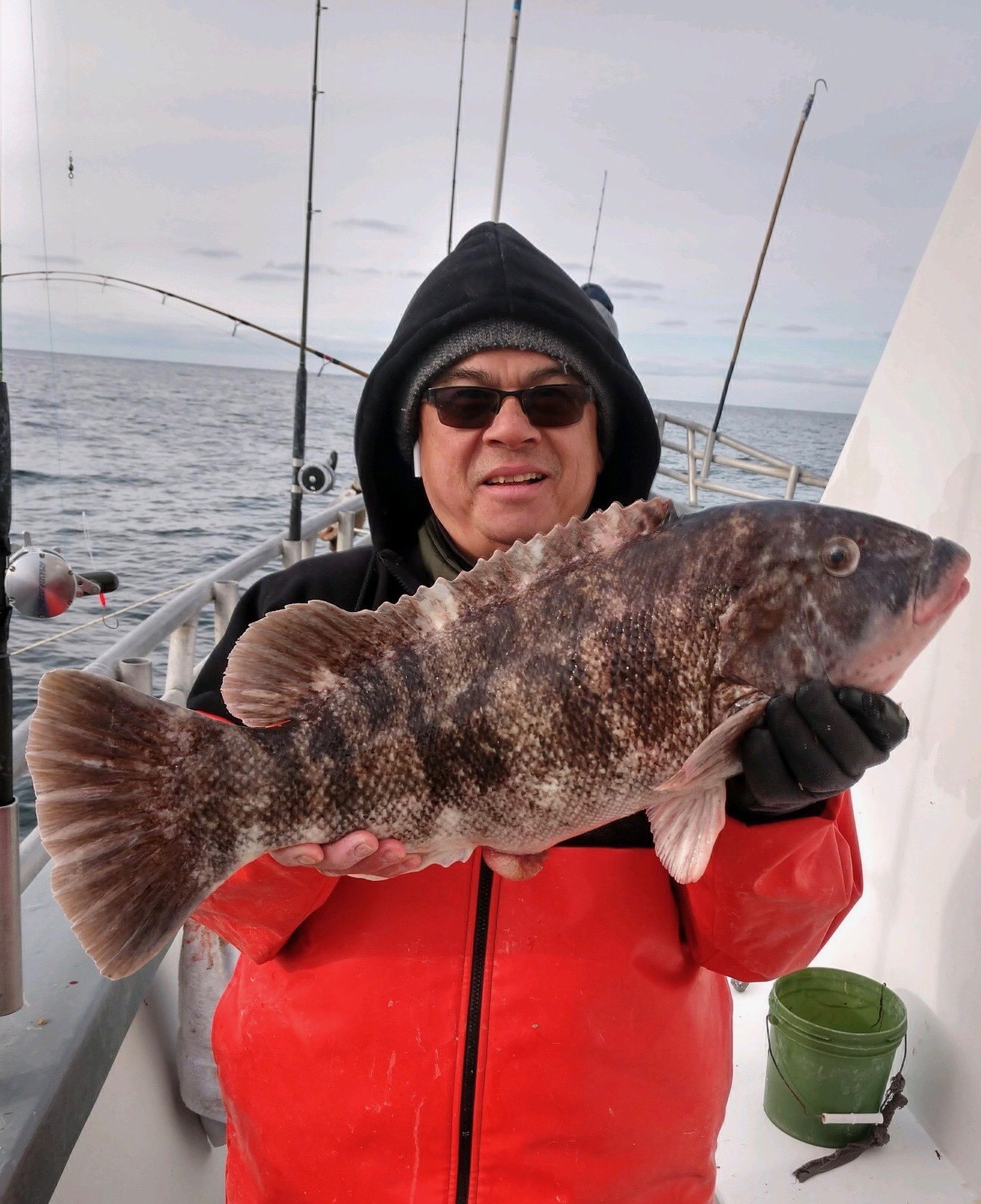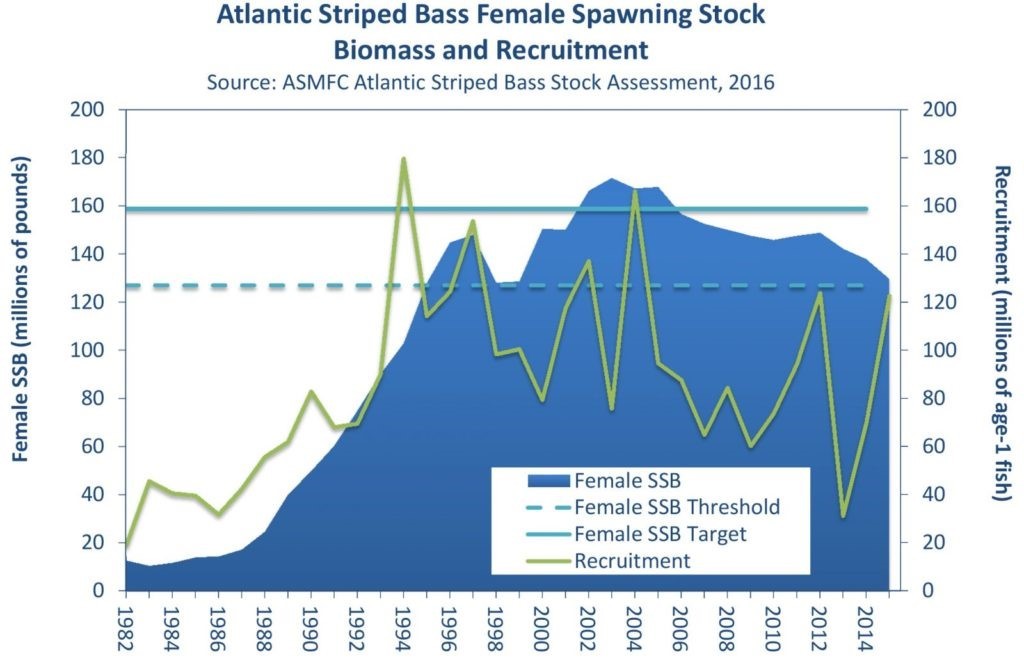Striped bass taking a dive
Having trouble dunking that basketball? Then lower the rim to eight feet. Having trouble scoring a touchdown on a 100 yard field? Well then shorten the field to eighty yards.
This is exactly what has and may happen again to striped bass and the level of spawning stock biomass (SSB) we need to have in the water to maintain the fishery at sustainable levels. The level of spawning stock biomass required to stay in the water may decrease even though we have less fish in the water because interest groups interested in bolstering the striped bass fishery are putting short term interests first, rather than the health of the striped bass fishery long term.
According to a new stock assessment summary report discussed during a striped bass webinar last month by the Atlantic States Marine Fisheries Commission (ASMFC), striped bass were overfished in 2017 and overall the stock is experiencing overfishing. The ASMFC manages striped bass and other migratory species on the east coast.
Biological Reference Points (BRPs) such as female Spawning Stock Biomass (SSB) in 2017 was 68,476 mt less than the SSB threshold of 91.436 mt, indicating the stock is overfished. The associated F threshold (another BRP that measures mortality rate) was 0.240 f; F 2017 was .307, indicating the stock is experiencing overfishing. See graphic chart with SSB and Recruitment from the new striped bass stock assessment.
Fish advocate and author Tony Friedrich of Virginia has been following striped bass health and catch limits for many years. He is a former executive director of the Coastal Conservation Association (CCA) of Virginia and is now a consultant for non-profit fish conservation organizations.
Tony Friedrich said, “There are many that will try to shift the baseline by lowering the Biological Reference Points (BRP)’s. They will say that the holding capacity of the Chesapeake Bay (one of two primary spawning and habitat growth areas where our striped bass come from) isn’t the same as 2006 when the stock peaked. They will say that the current levels are unattainable. How can we attain the proper population level, while killing them at this rate? They will try every trick in the book.” By lowering spawning stock biomass and mortality biological reference points anglers would be able to to take more fish.
It is up to anglers to rebuild striped bass and grow them to abundance so their more in the water for all of us to catch and eat. We need to hold off efforts to lower biological reference points.
Friedrich said, “It rests on our shoulders and ours alone to make sure the striped bass population recovers. It will take a herculean effort to turn the tide. But we can do it.” The ASMFC hopes to have a final peer reviewed stock assessment with recommendations by February, 2019. Anglers are urged to participate in workshops and public hearing held by the ASMF and the states of RI, CT and MA on striped bass to express their point of view biological reference points and 2019 harvest limits.
For a copy of Tony Friedrich’s recent article on the striped bass stock assessment visit www.fissues.org.
Rhody Fly Rodders Christmas Tackle Sale
The Rhody Fly Rodders, the oldest saltwater fly fishing club in America, will hold a Christmas Fly Tackle and Gear Sale on Tuesday, December 18, 6:30 p.m. at the Riverside Sportsmen’s Association, 1 Mohawk Drive, East Providence.
Peter Nilsen, president said, “We invite members to bring used and unwanted fly tackle and gear to sell at the meeting. We will also have a lot of items for sale from the estate of member Ron Montecalvo. The public is invited to attend the sale and meeting.”
For information contact Peter Nilsen at pdfish@fullchannel.net.
New bipartisan fishing bill expected to pass
At press time the U.S. Senate was expected to pass S. 1520, a bill that offers revisions to the fishing law of this nation, the Magnuson-Stevens Act (MSA). Last week, as the Senate started to finish business for their 2018 session, a bipartisan effort was made to alter the original bill.
The new bill (as it stands at press time) takes most of the harmful items detrimental to conservation and growing fish to abundant out of the bill. The House would have to pass a new bill as the original bill passed there (H.R. 200) is vastly different in that it contains many provisions that fish conservationists have objected to. A new companion bill may pass this week in the House as well.
More on MSA as legislation is developed and passed by Congress. Visit www.conservefish.org for MSA bill information.
Where’s the bite?
Tautog fishing was still good for anglers able to get out in the cold and rough seas last week. The Seven B’s party boat out of Pt. Judith reported, “Plenty of quality keepers throughout the day (Saturday) with the biggest around 8 lbs. Most anglers had their limit and everyone had at least a few.” Capt. Frank Blount of the Frances Fleet said, “We did have out final (tautog) trip on Saturday with some decent results. Biggest fish on the day was 10 pounds and a few cod showing up on the grounds to 20 pounds.” The tautog season in Rhode Island ends December 31.
Cod (and haddock) fishing. Captain Scott of the Island Current said, “On opening day for our first codfish trip of the season on Sunday we were able to see a nice variety of mixed bag which included codfish, black sea bass, blackfish, and haddock. There was even three blackfish over the 10 pound mark.” Capt. Frank Blount of the Frances Fleet said, “We were able get out almost every day this week and work on the haddock. Days where we were able to drift did see the best action. When we were on the hook we saw a variety of bottom dwellers that could not pass up the fresh clams. Cod, black sea bass, scup and ling rounded out every day catches. Saturday did see the best action on the cod. We saw an increase of mackerel and herring on the grounds so anglers started to jig. We had a solid jig bite for 2 hours and had fish to 15 pounds. This is a great sign for weeks to come.”
Captain Dave Monti has been fishing and shellfishing for over 40 years. He holds a captain’s master license and a charter fishing license. Visit Captain Dave’s No Fluke website at www.noflukefishing.com or e-mail him with your fishing news and photos at dmontifish@verizon.net.









